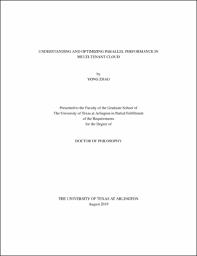
ATTENTION: The works hosted here are being migrated to a new repository that will consolidate resources, improve discoverability, and better show UTA's research impact on the global community. We will update authors as the migration progresses. Please see MavMatrix for more information.
Show simple item record
| dc.contributor.advisor | Rao, Jia | |
| dc.creator | Zhao, Yong | |
| dc.date.accessioned | 2019-08-27T20:23:46Z | |
| dc.date.available | 2019-08-27T20:23:46Z | |
| dc.date.created | 2019-08 | |
| dc.date.issued | 2019-08-12 | |
| dc.date.submitted | August 2019 | |
| dc.identifier.uri | http://hdl.handle.net/10106/28618 | |
| dc.description.abstract | As a critical component of resource management in multicore systems, fair schedulers in hypervisors and
operating systems (OSes) must follow a simple invariant: guarantee that the computing resources
such as CPU cycles are fairly allocated to each vCPU or thread. As simple as it may seem, we found this invariant is
broken when parallel programs with blocking synchronization are colocated with CPU intensive programs
in hypervisors such as Xen, KVM and OSes such as Linux CFS.
On the other hand, schedulers in virtualized environment usually reside in two different layers:
one is in the hypervisor which aims to schedule vCPU onto each pCPU and another is in the virtual machine
to schedule the processes. Such design principle will impose an implicit scheduling gap between these two layers
such that threads holding the lock or waiting for the lock in the virtual machine can be inadvertently descheduled by
hypervisors. This behavior will cause the well known LHP and LWP problems which can seriously degrade the performance
of parallel applications.
While the cloud is believed to be an ideal platform for hosting parallel applications, its nature of multi-user sharing
and resource over-commitment makes parallel performance often quite disappointing and unpredictable. Although
many research works have identified the excessive synchronization delays such as LWP and LHP due to multi-tenant
interferences as the culprit, there lacks a full understanding of the quantitative relationship between changes in
synchronization and the overall performance loss. As performance modeling plays a fundamental role in designing
traditional parallel systems, a systematic and quantitative study of parallel performance under cloud interferences
would help improve the resource and power management in datacenters.
This dissertation explores two fundamental questions towards the solutions for the scheduling unfairness and inefficiency
in multicore systems: why does the schedulers ``unexpectedly'' show to be unfairness under the common belief that
scheduling algorithms have been stable for many years and are already perfect? Why does the schedulers exhibit
effectively regarding to scheduling the parallel applications in physical environment but perform badly in the cloud?
The goal of this dissertation is to enable multicore systems to proactively anticipate and defend against the scheduling
unfairness and inefficiency, rather than reacting to their manifestations and consequences.
This dissertation presents three key principles of systems design and implementation for rethinking and redesigning
the scheduling algorithms in multicore systems against the unfairness and inefficiency---preemptive multiple queue
fair queuing, interference-resilient scheduling, and differential scheduling. This dissertation demonstrates that applying
these principles can effectively defend scheduling unfairness and inefficiency in multicore systems. Furthermore, this
dissertation also presents the corresponding techniques and tools support that can automatically and systematically apply
these principles into existing multicore systems.
Scheduling algorithms which originated from scheduling the
packets in single-linked network were widely used in computer systems,
however scheduling unfairness are unexpectedly manifested through scaling these algorithms
from single core to multicore systems. Scheduling inefficiency are usually caused by the implicit semantic gap existing
in the virtualized environment. Thus, this dissertation has modified the
design of single-linked scheduling algorithm to make them to be fairness in face of the multiple-linked network and
furthermore applied them into the multicore system scheduling to eliminate the unfairness. Instead of leaving the scheduling
activities in two virtualized layers transparently for each other, this dissertation first characterized the performance
of parallel applications under interference and then proposed methods to bridging the semantic gap in order to
remove the scheduling inefficiency. | |
| dc.format.mimetype | application/pdf | |
| dc.language.iso | en_US | |
| dc.subject | Operating system | |
| dc.subject | Computer architecture | |
| dc.subject | Virtualization | |
| dc.subject | Parallel computing | |
| dc.title | Understanding and Optimizing Parallel Performance in Multi-tenant Cloud | |
| dc.type | Thesis | |
| dc.degree.department | Computer Science and Engineering | |
| dc.degree.name | Doctor of Philosophy in Computer Science | |
| dc.date.updated | 2019-08-27T20:24:52Z | |
| thesis.degree.department | Computer Science and Engineering | |
| thesis.degree.grantor | The University of Texas at Arlington | |
| thesis.degree.level | Doctoral | |
| thesis.degree.name | Doctor of Philosophy in Computer Science | |
| dc.type.material | text | |
Files in this item
- Name:
- ZHAO-DISSERTATION-2019.pdf
- Size:
- 2.376Mb
- Format:
- PDF
This item appears in the following Collection(s)
Show simple item record


